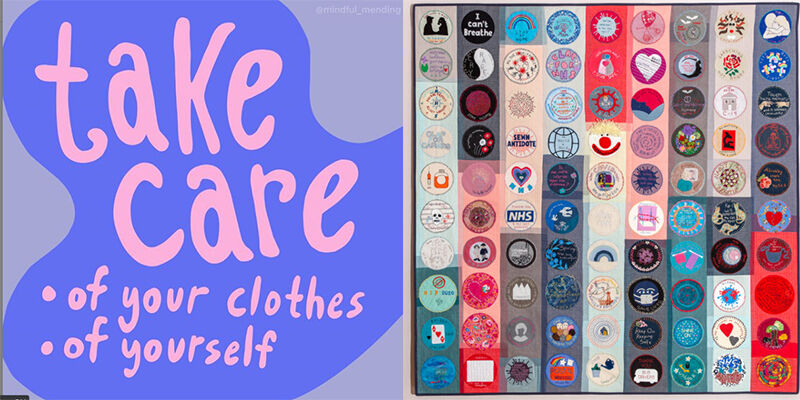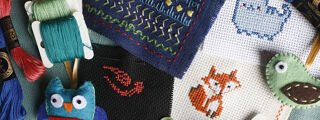As part of a module in their degree, second year students on our BA (Hons) Textile Design course have written about contemporary issues affecting the textile industry, with particular emphasis on a professional job role and industry sector of their choice.
Lecturer Sarah Burton commented: “This project always provides a great opportunity for students to learn more about global issues affecting the textile industry, as well as gain further understanding of a specific job role that they aspire towards. This year, as the ongoing effects of the Covid-19 pandemic on the industry continue to be felt, students have questioned what the ‘new normal’ is for our industry and considered how designers and creatives will need to adapt in the ever-changing environment."
Here, Jade Durling discusses how textile projects have become an important source of mindfulness during lockdown.
Wellbeing has become increasingly important over this last year, from contending with unknown circumstances to ever-changing guidelines. Textiles has helped many of us to reconnect with ourselves and give focus to our lives. Particularly hand embroidery, which can be used to practice mindfulness, a technique I have been using. As well as this I am exploring the links between the idea of ‘wellbeing’ and how textile artists and makers have responded to the opportunities and challenges they have faced, while speculating about what the future may look like for this creative contemporary industry.
Sustainable thinking and handcraftsmanship have grown in popularity online, specifically Instagram. The platform has given an opportunity for artists to spread awareness on the benefits of mending and emphasising ‘making do with what you have’ in efforts to reduce waste. It has also given the chance for creatives to pursue their goals of creating their own small businesses on platforms such as Etsy and promoting themselves. Makers have been advocating for others to shop small which has helped these new local businesses grow and thrive. In addition to this, on apps such as TikTok, makers have been encouraging their audience to learn new hand-crafted skills. In fact, I have done this myself, teaching my friends how to stitch and mend clothes. This collaborative session gave us all a sense of positivity and let us take something good out of the current pandemic.
Social media has additionally played a large part of connecting with others due to exhibitions and events being cancelled. Artists balancing home life with work, as they can to longer return to studios, have therefore created online workshops to reconnect with their audience. Maker Erin Eggenburg has been documenting this through her Instagram. She has uploaded live videos in which she would set challenges for her followers to continue productivity and boost morale. Many other artists and galleries have taken this direction using apps such as Microsoft Teams and Zoom to stay connected, which we will likely continue into our future.

Left: Positive Message posted on Mindful Mending Instagram page (Lily Fulop, 2020), Right: Sewn Antidote, Collaboration Piece (Lara Hailey 2020)
Lockdown has given people time to reflect on their practice. This surplus has been comforting for some, letting them experiment and finish projects that were once forgotten. Some have also taken positive action to reconnect with nature or learn additional new skills. Whereas others, such as Lisa Call, have felt guilt for lack of production in comparison to their peers. While artists have been celebrating their work, collaborations and efforts to help with PPE it has created a high expectation for other artists to perform to that standard. Seeing everyone managing to adapt quickly when you cannot catch up yourself is disheartening. Personally, I have struggled with this challenge myself however I understand that not everyone can work under certain pressures.
Amid the pandemic, collaborations and communities have expanded to form pieces that highlight their own experiences. It has helped turn the anxieties of isolation and being alone into creating safe places where people are given a creative purpose. While some makers’ motivation levels may have been low, collaborating helped people to get back into a creative mind set. To keep my own mind off the intensity of lockdown restrictions I created a miniature project of repairing socks. This allowed me to slow down, appreciate the practice and mindfulness.
As well as activism-driven pieces, hobbyists and professionals have also been making PPE and coverings for frontline workers and the general public. The sudden change meant there was a shortage of such equipment, however, thanks to volunteers getting involved in this ‘collective action’, it helped people nationwide. I believe this truly shows the importance of textile makers, their contributions and how their knowledge is vital.
So, what does the future look like? Textile artists have become comfortable with the new norm of the online world; I know I have. Planning for social interactions such as exhibitions and meet-ups will need to be considered carefully to ensure health and safety. This change may seem like the sense of ‘community’ is forced. However, I believe that through the hardships that artists have faced and the tolls it has taken on mental health, their reflection and support has powered them through the restraints of multiple lockdowns. I therefore imagine the importance of ‘wellbeing’ will remain significant towards the future.





